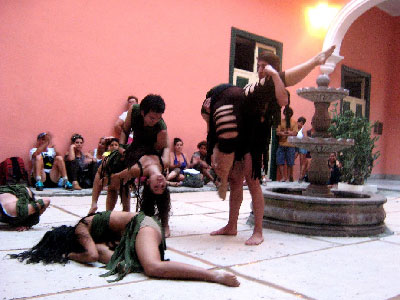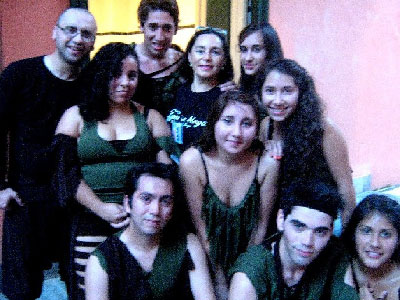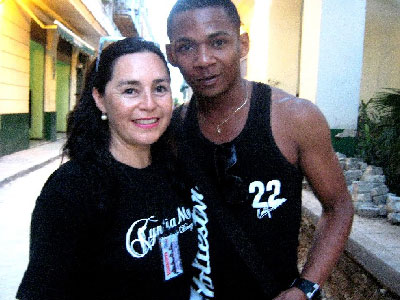‘Cyma’ Aims for the Summit
Yusimí Rodríguez

HAVANA TIMES — One of the dance companies whose performances we enjoyed during Havana’s recent “City in Motion” (“Ciudad en Movimiento”) Street Dance Festival is Cyma, a Chilean troupe directed by Cyntia Moya. I had the pleasure of seeing one of their performances at the Casa de Benito Juárez on April 11.
After the show, while the dancers retreated to and emerged from their changing rooms and had photos taken beside Benito Juárez’s statue, I managed to hold something of an informal exchange with them.
HT: Have you participated in previous “City in Motion” festivals?
Cyntia: No. This is our first trip to Cuba. It is also the first time we’ve performed outside of Chile as a company, since its creation ten years ago.
When we saw the call for participation, we were thrilled by the idea of taking our performance out to the street, to public spaces far from the stage, without charging admittance. In fact, we have no theatre to perform in in Chile. We rehearse in a basement and perform wherever we can. We go to schools and parks. We adjust the choreography to fit the space we perform in. After the earthquake, for instance, we went out to the street, spread out a large piece of linoleum on the ground, and offered a performance there.

We were very much interested in participating in the festival, but it is only thanks to the Curicó City Hall that we were able to come. Curicó means “dark tide” in Mapuche. We are deeply grateful to Mayor Javier Muñoz, who believes in the work of young artists, who secured the money and the tickets for us to travel here.
HT: Did they also cover your living expenses?
Cyntia: The plane tickets are the most expensive thing. We can afford to pay our own living expenses. We’re not staying in hotels, we’re staying in casas particulares. We’ve brought gifts for people as well.
HT: Tell me about this dance number. Why is it called “On the World’s Edge”?
Cyntia: Actually, they made a mistake when they included the title in the program. The actual title is “At World’s End”. We gave it this title because, as Chileans, we are in fact almost off the map. We prepared this number specifically for the festival. We sat down and had a group discussion. We decided we wanted to show Cubans who we are and the problems we face in Chile. The choreography alludes to the natural disasters we’ve seen, and also speaks of the machismo and gender-related violence we live with. Many women are murdered in Chile as a result of domestic violence, and we wanted to convey that as well.
HT: What are your impressions of Cuba so far?
Cyntia: We have liked the country and its people very much. Cubans are very friendly and affectionate. But the police struck us as rather odd.

Our friend Davel is Cuban. He is the son of one of our friends here, who is married to a Chilean. When they confirmed we would be traveling to Cuba, I called him so that he would pick us up at the airport and act as our guide here. He goes with us everywhere, gives us directions, protects us. The police, however, have stopped him on three separate occasions and asked for his ID.
I must mention that one of the things about this dance troupe that caught my attention is the physique of one of its performers, a young woman with an important part in the piece, which is far more robust than what one is accustomed to seeing in Cuban and foreign companies. In Cuba, ballerinas have thin, athletic, stylized bodies. In fact, many people have, on occasion, asked me whether I was once a ballerina, because of my very slim figure.
If a girl is a bit hefty and is interested in becoming a ballerina or dancer, her family tells her she must lose weight. There’s even a dance company in Cuba called “Danza Voluminosa”, made up of people with figures that are considerably thicker than those of traditional ballet performers.
The argument in defense of the nearly obligatory slimness of ballerinas is that it is very difficult for the male dancer to lift the female if she is not thin. This, however, does not seem to be problem for Valeria Alarcón Valderrama, a twenty-five year old dancer who has been performing since the age of eleven. In fact, she was surprised by my question:
HT: Has your body weight ever stood in the way of your career?
Valeria: Absolutely not. I don’t know if it’s ever been a problem for those who see me perform, but I’ve never been worried about it.

HT: No one has ever asked you to lose weight so the male dancers can lift you up more easily?
Valeria: Never, and I’ve performed with another company. Plus, you saw how easily the boys lift me up.
Cyntia: We have anti-discrimination laws in Chile which forbid discrimination at school, work or any sphere, be it on the basis of skin color, gender, religion, sexual orientation or body build. In this case, what matters is the person’s talent and Valeria has plenty of it. Did you notice she is a prima ballerina? She’s also a choreographer and dance instructor. This number, “At World’s End”, was choreographed by her and Ariel Reyes Becerra, another dancer and choreographer in the company.
The one obstacle Valeria has faced to date is her family.
Valeria: My family doesn’t want me to be a dancer, because you don’t make much money in the profession. You can’t make a living as a dancer in Chile. I am studying to become a nurse, I’m in fifth year.
Cyntia: I tell her she should give the degree to her family, to make them happy, and to start training to become a professional dancer.
HT: Doesn’t anyone make a living as a dancer in Chile? How do dancers survive there, then?
Cyntia: They perform out of love of dancing. I don’t know of a single dancer who earns a salary for dancing as such. People become instructors and hold other types of jobs. I have a dance school. Many of the dancers in my company are instructors there. Others are taking dance lessons. Still others have other types of jobs.
HT: What does the company name, Cyma, mean?
The dancers tell me it is formed using the director’s name, Cyntia Moya.
Cyntia: That too. But it also invokes the word “cima”, “summit”, in Spanish. That is our goal, to reach artistic heights, summits, as dance performers.
HT: What are your thoughts about the “City in Motion” Festival?
Cyntia: I’ve liked it so much that I’ve asked the organizers to let me use its name, to hold a similar festival in Chile, with whole companies dancing out in the street. We would invite Cuban companies too. I think it would be wonderful.
Before saying goodbye, Cyntia again expresses her profound gratitude towards the Curicó City Hall.
Cyntia: We can’t miss an opportunity to thank Javier Muñoz and Julieta Maureira Lagos, the Cultural Commission Attaché.





